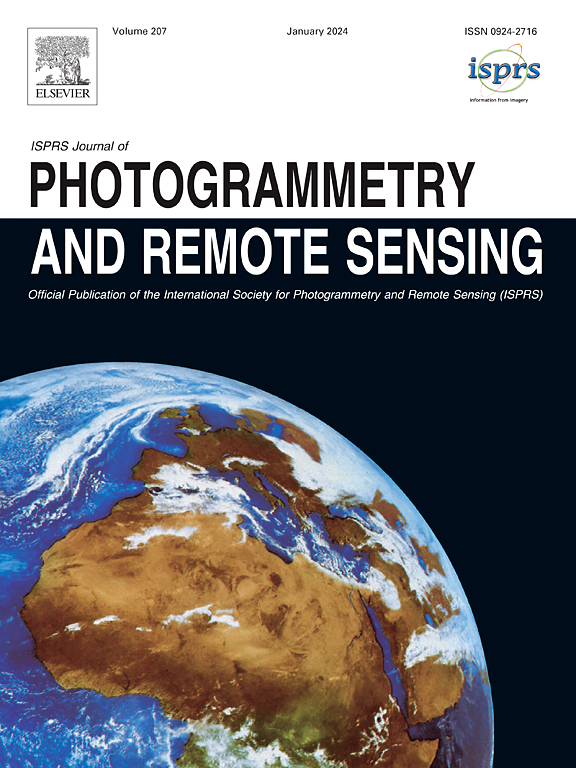hroad:一种具有混合注意和方向先验的编码器-解码器架构,用于从遥感图像中有效地提取道路
IF 10.6
1区 地球科学
Q1 GEOGRAPHY, PHYSICAL
ISPRS Journal of Photogrammetry and Remote Sensing
Pub Date : 2025-06-18
DOI:10.1016/j.isprsjprs.2025.06.014
引用次数: 0
摘要
由于道路结构形态多变、语义复杂性高,从甚高分辨率(VHR)遥感图像中提取道路面临着巨大的挑战。许多现有的方法都难以在各种复杂的场景中始终如一地表现良好。此外,平衡效率和性能在先前的研究中仍然是一个未解决的问题,特别是那些使用变压器的研究。为了解决这些挑战,我们提出了HDRoad,这是一种新型的编码器-解码器架构,可以提高模型性能和计算效率,可以使用单个GPU对高分辨率输入进行训练和推理。混合注意网络(HA-Net)编码器结合了密集和稀疏的空间注意来有效地提取语义信息。解码器,定向增强道路形态提取网络(DARMEN),使用形态学先验来精确地提炼和重建道路特征。该模型在DeepGlobe数据集和SouthernChina12k上进行了验证,后者是一个新开发的道路分割数据集,包含来自各种遥感来源的11,791幅图像。实验结果表明,hroad在DeepGlobe数据集上实现了75.09%的IoU,是中国南方12k上唯一一个超过60% IoU的模型,为该领域最先进的性能设定了新的基准。本文章由计算机程序翻译,如有差异,请以英文原文为准。
HDRoad: An encoder-decoder architecture with hybrid attention and directional prior for efficient road extraction from remote sensing images
Road extraction from very high resolution (VHR) remote sensing images (RSIs) presents significant challenges due to the varied morphology and high semantic complexity of road structures. Many existing methods struggle to consistently perform well across diverse and complex scenarios. Additionally, balancing efficiency and performance remains an unresolved issue in prior research, particularly those employing transformers. To address these challenges, we propose HDRoad, a novel encoder-decoder architecture that improves both model performance and computational efficiency, enabling training and inference on high-resolution inputs with a single GPU. The encoder, Hybrid Attention Network (HA-Net), combines dense and sparse spatial attention to effectively distill semantic information. The decoder, Directional Augmented Road Morphology Extraction Network (DARMEN), uses morphological priors to accurately refine and reconstruct road features. The model is validated on the DeepGlobe dataset and SouthernChina12k, a newly developed road segmentation dataset comprising 11,791 images from various remote sensing sources. Experimental results demonstrate that HDRoad achieves an IoU of 75.09 % on the DeepGlobe dataset and is the only model exceeding 60 % IoU on SouthernChina12k, setting new benchmarks for state-of-the-art performance in the field.
求助全文
通过发布文献求助,成功后即可免费获取论文全文。
去求助
来源期刊

ISPRS Journal of Photogrammetry and Remote Sensing
工程技术-成像科学与照相技术
CiteScore
21.00
自引率
6.30%
发文量
273
审稿时长
40 days
期刊介绍:
The ISPRS Journal of Photogrammetry and Remote Sensing (P&RS) serves as the official journal of the International Society for Photogrammetry and Remote Sensing (ISPRS). It acts as a platform for scientists and professionals worldwide who are involved in various disciplines that utilize photogrammetry, remote sensing, spatial information systems, computer vision, and related fields. The journal aims to facilitate communication and dissemination of advancements in these disciplines, while also acting as a comprehensive source of reference and archive.
P&RS endeavors to publish high-quality, peer-reviewed research papers that are preferably original and have not been published before. These papers can cover scientific/research, technological development, or application/practical aspects. Additionally, the journal welcomes papers that are based on presentations from ISPRS meetings, as long as they are considered significant contributions to the aforementioned fields.
In particular, P&RS encourages the submission of papers that are of broad scientific interest, showcase innovative applications (especially in emerging fields), have an interdisciplinary focus, discuss topics that have received limited attention in P&RS or related journals, or explore new directions in scientific or professional realms. It is preferred that theoretical papers include practical applications, while papers focusing on systems and applications should include a theoretical background.
 求助内容:
求助内容: 应助结果提醒方式:
应助结果提醒方式:


